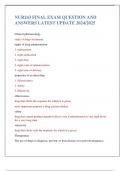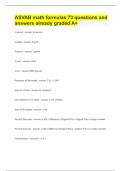NUR243 FINAL EXAM QUESTION AND ANSWERS LATEST UPDATE 2024/2025 Clinical pharmacology study of drugs in humans rights of drug administration 1. right patient 2. right medication 3. right dose 4. right route of administration 5. right time of delivery properties of an ideal drug 1. Effectiveness 2. Safety 3. Selectivity effectiveness drug that elicits the response for which it is given most important property a drug can haveSafety safety drug th at cannot produce harmful effects even if administered in very high doses for a very long time selectivity drug that elicits only the response for which it is given Therapeutics The use of drugs to diagnose, prevent, or treat disease or to prevent pregnanc y -the medical use of drugs OTC drugs Medications that are legally available without a prescription OTC abuse easily available perceived safety poorly understood Patient adherence the extent to which a patient's behavior coincides with medical advice chemi cal name The name that describes the chemical composition and molecular structure of a drug. generic name legal noncommercial name for a drug trade name a commercial, legal name under which a company does business Therapeutic Response the intended (beneficial) effect of a drug Post marketing surveillance Monitor for therapeutic effects and adverse reactions from the drugs Reporting adverse reactions Be aware of drugs that have been recalled or reported dangerous FDA holds annual public meetings FDA will withdraw a drug if serious problem found Phases of clinical testing for new drugs Phase 1: healthy volunteers (evaluating drug metabolism, pharmacokinetics, biologic effects Phase 2/3: tested in pts to determine therapeutic effects, dosag e range, safety, effectiveness Phase 4: postmarketing surveillance Pharmacokinetics study of the drug movement throughout the body absorption drug movement from its site of administration into the blood distribution drug's movement from the blood to the in terstitial space of the tissues and into the cells metabolism (biotransformation, detoxification) enzymatically mediated alteration of drug structure excretion movement of drugs and their metabolites out of the body Toxic concentration level of drug that w ill result in serious adverse effects Therapeutic range that concentration of drug in the blood serum that produces the desired effect without causing toxicity minimum effective concentration amount of drug required to produce a therapeutic effect Plasma drug level Lab values obtained for a certain drugs to ensure dose is therapeutic Blood Brain Barrier a filtering mechanism of the capillaries that carry blood to the brain and spinal cord tissue, blocking the passage of certain substances, has PGP ( pumps drugs back into the blood) -lipid soluble -transport system that can cross the BBB Protein binding the attachment of a drug molecule to a plasma or tissue protein, effectively making the drug inactive but also keeping it within the body -albumin most popular to bind with, percentage of drug molecules that are bound is determined by the strength of the attraction between albumin and the drug Drug half -life the time required for the amount of drug in the body to decrease by 50% P450 system group of enzy me families in the liver which metabolize drugs and endogenous compounds rate at which drugs are metabolized are affected by inducers (increase) and inhibitors (decrease) the rate of drug metabolism (as metabolism increases, drug levels fall) First-pass ef fect The initial metabolism in the liver of a drug absorbed from the gastrointestinal tract before the drug reaches systemic circulation through the bloodstream. IV ADVANTAGES absorption bypassed instantaneous rapid onset, ideal for emergencies precise con trol over drug levels large fluid volumes
Exam (elaborations)
NUR243 FINAL EXAM QUESTION AND ANSWERS LATEST UPDATE 2024/2025
Rating
Sold
-
Pages
56
Grade
A+
Uploaded on
16-06-2024
Written in
2023/2024
NUR243 FINAL EXAM QUESTION AND ANSWERS LATEST UPDATE 2024/2025
Institution
NUR243
Course
NUR243
Whoops! We can’t load your doc right now. Try again or contact support.
Written for
- Institution
- NUR243
- Course
- NUR243
Document information
- Uploaded on
- June 16, 2024
- Number of pages
- 56
- Written in
- 2023/2024
- Type
- Exam (elaborations)
- Contains
- Questions & answers
Subjects
- nur243 final exam
-
nur243 final exam question and answers latest
-
nur243 final exam question and answers
-
nur243 final exam question and answers
Content preview
$22.99
Get access to the full document:
100% satisfaction guarantee
Immediately available after payment
Both online and in PDF
No strings attached
Also available in package deal

Package deal
NUR 243 FINAL EXAM QUESTIONS AND ANSWERS (VERIFIED) LATEST UPDATE 2024/2025
7
2024
$ 159.93
More info


